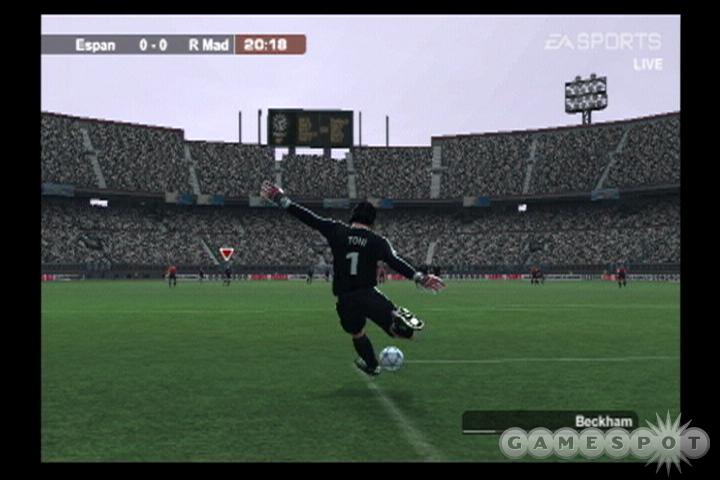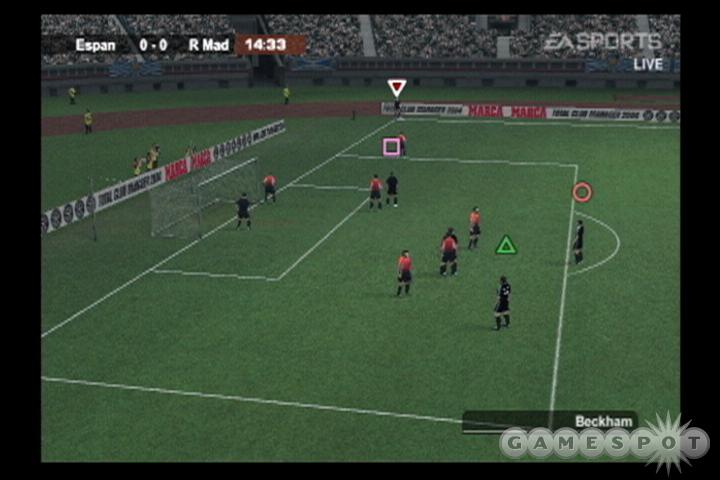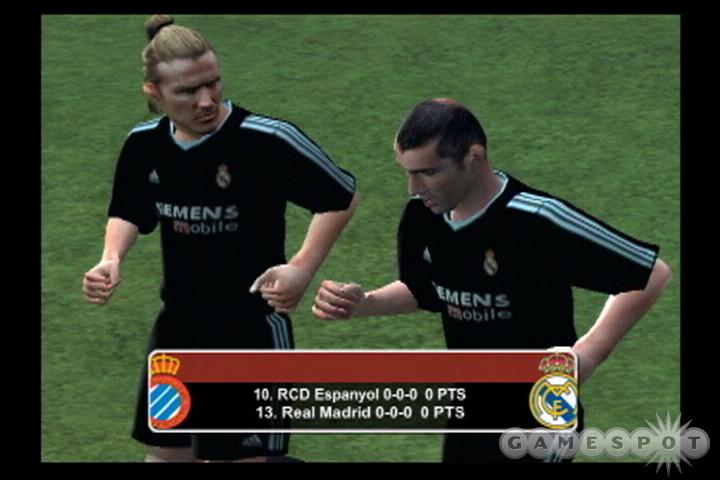Electronic Arts has been making some pretty major changes to its long-running FIFA Soccer series in recent years, and its 2004 edition is no exception. The game features the same slick presentation, official licenses, and instantly recognizable players that the series is known for, but it also boasts a number of enhancements, including a goal-driven career mode, online play on the PS2, more realistic ball physics, and the well-publicized off-the-ball control. FIFA Soccer 2004 is undoubtedly EA Sports' most realistic soccer game to date. Though some of the new features will inevitably take you a while to get used to--and there's still plenty of room for improvement--it manages to be both enjoyable and challenging.

FIFA Soccer 2004 features more than 350 real teams from all over the world, and the first thing you're required to do after booting up the game for the first time is let it know which team you support--or at least which team is your favorite. From that point onward, either your chosen team's colors or those of the league they play in will appear on menu screens within the game. Additionally, your chosen team will also become the default selection for the game's exhibition and practice modes. The other modes of play on offer include no fewer than 17 real cup tournaments and an all-new career mode in which you can attempt to lead any of the clubs featured in the game to glory by using your skills both on the pitch and on the transfer market. In addition to all of that, the PlayStation 2 version features online play, which works well and adds another layer of competition and longevity to the game.
After selecting a team to manage in career mode, you'll be given a one-year contract, and then you'll be presented with a series of objectives for the upcoming season. Each of the objectives presents a certain number of prestige points for you if you successfully complete it. In fact, you'll be required to attain a certain number of points each season if you wish to keep your job. Your objectives will vary according to the expectations of the club you're managing, so, for example, one of the smaller teams in the English Carling Premiership might award you prestige points for simply avoiding relegation (in essence, this is a team demotion for not performing as well as expected for a given season) or for conceding fewer than 50 goals in a season. Manning the helm at a major team like Manchester United, for example, will require you to become league champions or, at the very least, it will require you to qualify for one of the big European competitions. Teams will also stipulate certain conditions that could see you losing points, like being relegated or finishing the season with a negative goal difference. These prestige points challenges not only serve to keep the game interesting, no matter what stage of a season or a career you're at, but they also act as a constant reminder of the pressures that face soccer managers in real life.
Prestige points represent your reputation as a manager, and they should increase as you progress through your career--depending on your achievements, of course. The number of prestige points you have determines how much training you can put your players through each week, and they also determine the likelihood of your being able to attract other players to your club. The 1000 points you start out with will basically be enough to keep your whole team in regular training, and they will also provide just enough extra points to offer some more-specialized training routines to select, key players. These routines focus on such areas of play as sprinting, passing, and shooting. Needless to say, as you become a better manager, and the number of points at your disposal increases, your whole team is able to benefit from additional training. Although each exercise has a cost attributed to it that varies according to the selected player's current skills, prestige points aren't actually spent on training as such. If you have 1000 prestige points, that means you can select 1000 points worth of training every week. Player transfers, however, are an entirely different matter.
When attempting to sign a new player to your team, you'll notice that, in addition to his monetary value, each player carries a prestige points cost. English national team captain David Beckham, for example, is worth a lot of money in the game, so, in order to tempt him away from Spanish giants Real Madrid, you'd also need to part with 1000 prestige points. It initially seems strange that you should lose prestige points simply for signing a player, particularly since, in this instance, it might mean that the rest of your team has to go without training for the rest of the season. The system actually makes a lot of sense when it comes to gameplay. By assigning a prestige point cost to players, EA has not only effectively put a cap on the number of players that you can purchase in a single season, but it also encourages you to work with the players you already have by pouring resources into their training. You still, of course, have the option of spending all of your prestige points on a star player if you think that particular individual is good enough to justify the rest of your team missing out on training--to some extent. Should your star become injured, however, you could find yourself regretting the decision to put all of your eggs in one basket. As you've probably gathered, FIFA 2004's career mode offers a fair amount of depth and will certainly provide more longevity than any feature found in previous FIFA offerings. We'd even go so far as to say that it represents some serious competition for the master league mode found in Konami's Winning Eleven 6 International, except that the action on the pitch isn't quite there yet.

Unsurprisingly, the first thing that strikes you about FIFA 2004, once you've made it past the menu screens, is that EA has once again improved upon last season's visuals. All of the 20 real stadiums and 10 generic stadiums boast a high level of detail, and all of the more famous players are instantly recognizable as they exit the tunnel and step out onto the turf. It's unfortunate, although inevitable, that the majority of the game's 10,000 players clearly haven't had as much development time lavished on their looks as the likes of English favorites David Beckham and Michael Owen. None of the players in the game could really be described as generic though, and EA has obviously taken the time to ensure that no two players on a single team look the same. The team strips (uniforms) are equally impressive and boast all of the official sponsor logos and team badges, in addition to the requisite player names and numbers. Patches of mud can also be seen to appear on the kits (uniforms) of players if a game is being played in less than clement conditions. This represents a nice touch that really adds to the sense of realism when players are seen up close in action replays and the like.
Fans of previous FIFA games, or of any soccer games for that matter, shouldn't have too much difficulty picking up FIFA 2004. It's actually a good idea to play your first few matches without even attempting to try out the new off-the-ball controls, just to get a feel for the game's basic controls, which, incidentally, are more responsive than in previous FIFA titles. The fact that the amount of pressure you exert on the analog stick has no effect on your players' speed could take some getting used to if you've been playing some of the other soccer games available, but using the trigger buttons as walk and sprint modifiers actually works very well. Being able to slow your players down to a walk at the push of a button certainly comes in very handy when you want to shield the ball from opponents, since it allows you to move in different directions without actually changing the way that your player is facing.

Another extremely useful new feature in FIFA 2004, which fans of Konami's soccer games have been employing for years, is the ability to have one of your defenders pursue an opponent in possession of the ball simply by holding down a single button. The purpose of this feature isn't really to allow you to have two players gang up on a single opponent--although that certainly works on occasion--but it's designed to let you have a second player attempt to get the ball while you concentrate on marking another opponent, just in case the first one manages to release a pass. The players that you send after the ball perform their function admirably--most of the time. Since they more or less just aiming for the ball in a straight line at all times, there are occasions--mostly when the opposing player is sprinting--that you'll wish they had the intelligence to take the other player's movement into consideration when deciding on their intercept courses.
The most publicized new feature of FIFA 2004, and the one you're probably the most curious about, is EA Sports' new off-the-ball control. To explain it simply, the system allows you to control a second player's movement on the field by using the second analog stick. Really, there's a lot more to it than that. In addition to being able to send players off on runs, as in FIFA 2003, you're now able to exert various levels of control over these runs by using the right analog stick. The simpler technique, of the two available, allows you to alter the direction of the player's run by simply flicking the analog stick accordingly. Once you're comfortable with this one, though, you'll definitely want to spend some time mastering the second. When looking to pass the ball, you now have the option of highlighting three potential receivers. You choose one and then move him in exactly the same way as you're moving your current player--though now you're using the second analog stick. You've probably guessed that this is, by no means, easy, and, to be honest, we've found it to be a system that's best used sparingly. This is particularly true of multiplayer games when your opponent will be able to see exactly what you're up to. When used to good effect, though, the off-the-ball controls are incredibly satisfying, to say the least, and make for far less predictable patterns of play. Incidentally, the off-the-ball system also makes it a lot easier to pick out specific players when you're crossing the ball into the opposing team's goalmouth.
As great as everything is sounding up to now, FIFA 2004 isn't without its fair share of problems. For one thing, the menu option to move players between teams--so that you can keep them current--is next to useless since any player moving from one team to another has to be swapped one-for-one. So, for example, if David Beckham were to return to Manchester United, one of the existing Manchester players would have to take his place at Real Madrid. The TV-style camera angles used for corner kicks are also problematic, not only because the "jostling for position in the box" gameplay that EA has attempted to implement in these situations doesn't work terribly well but also because the camera takes just a little too long to return to normal once the set piece is over. Depending on which corner the kick is being taken from, the camera change can also have the effect of making you attack from left to right and then from right to left and back again in a relatively short space of time. This, of course, can get confusing.
Problems can also arise when you attempt to use the newly implemented in-game management (IGM) system to alter your team's tactics during gameplay. After calling up the IGM menu, you use the directional pad to determine whether you're changing a defensive strategy, an attacking strategy, or a formation preference, and then you choose the strategy from one of three more options. It sounds simple enough, but it takes just a little too long to do, and so it's best attempted only when play is stopped. A simple list of all nine options to scroll through would've been easier to tackle, particularly since the existing menus of three options apiece don't allow you to jump from option three back to option one without scrolling back through option two.
Finally, we've been disappointed to discover that the majority of the goals scored in FIFA 2004--at least those scored by us--have been the result of powerful shots unleashed a good distance from the goal. A goal is a goal, of course, and not all of those scored in real life are works of art, despite what strikers say. The fact that the game rewards players who are trigger happy over and above those who are looking to play the beautiful game in a beautiful way, certainly doesn't seem to be in keeping with the game's new off-the-ball style of play. Cranking the game up to its fourth and highest difficulty setting certainly makes the keepers harder to beat, but they're often still not quick enough to come out for balls, nor are they fast enough to react to shots taken from a distance.

An area of FIFA 2004 that certainly doesn't disappoint is its sound effects, commentary, and soundtrack. Matches take place in stadiums packed with supporters who cheer at all the right times and know the correct chants for some of the bigger teams. The in-game commentary from BBC favorites John Motson and Ally McCoist is both accurate and nonrepetitive. It'll come as no surprise to those who have played an EA Sports title recently that the game also boasts an impressive lineup of licensed music, including tracks from the likes of The Dandy Warhols, Kings of Leon, The Jam, Radiohead, and Timo Maas.
Despite being less visually impressive than the Xbox and GameCube versions of FIFA 2004 (which, incidentally, are the only two that offer progressive scan support), the PS2 version of the game is undoubtedly the pick of the bunch. Not only is it the only console version to offer online play, but the official PS2 controller is by far the best-suited one for the game's occasionally demanding controls. The PlayStation 2 is also where FIFA 2004 will face its stiffest competition. As much of an improvement over its predecessor as the game is, it's still not quite in the same league as Winning Eleven 6 International and can really only be recommended over Konami's offering to those of you for whom online play is key.